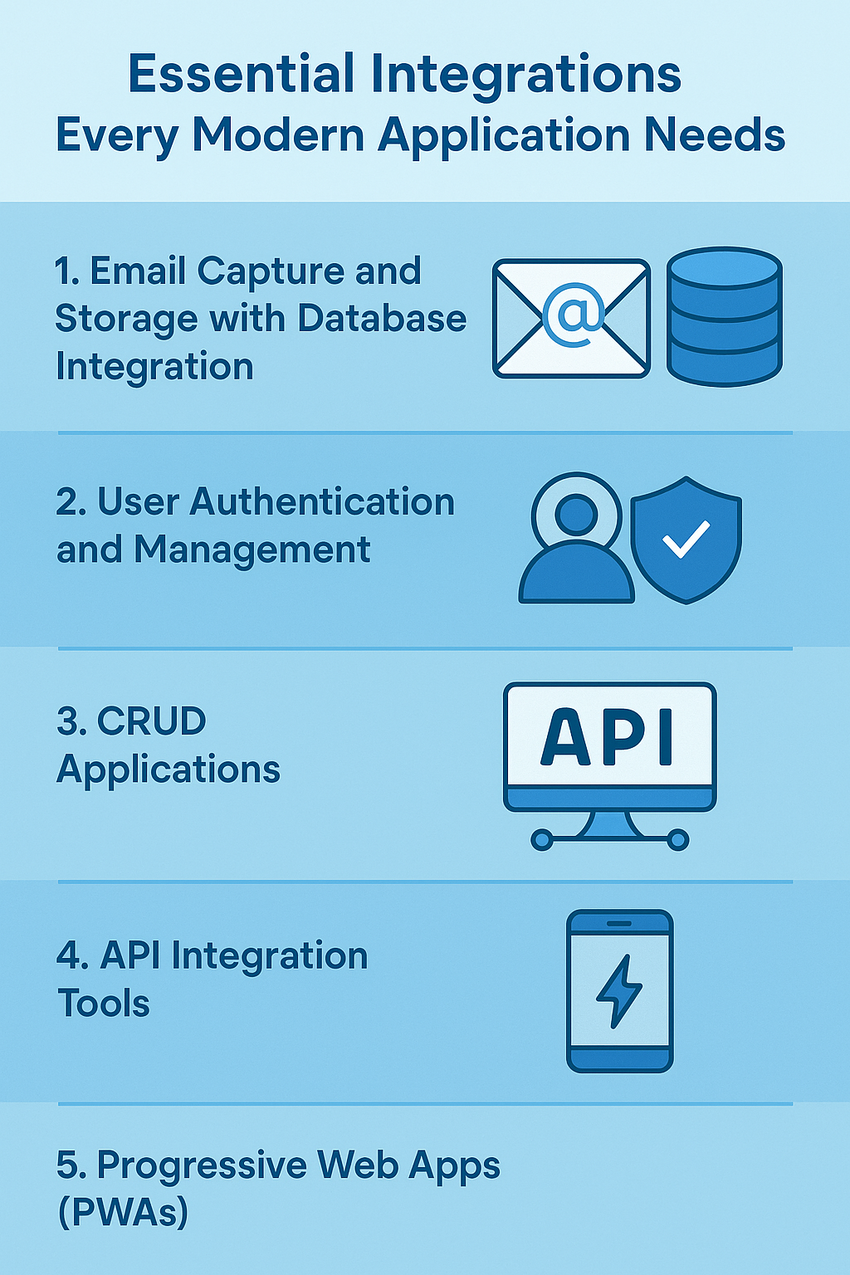Essential Integrations Every Modern Application Needs
Essential Integrations Every Modern Application Needs
In today's digital ecosystem, no application exists in isolation. Whether you're building a startup's MVP or scaling an enterprise platform, certain integrations have become fundamental building blocks that users expect and businesses require. Understanding these core integrations can help you architect more robust, user-friendly applications from the ground up.
1. Email Capture and Storage with Database Integration
Email capture sits at the foundation of digital customer relationships. This integration goes far beyond simply collecting email addresses—it encompasses the entire lifecycle of user data management.
A proper email capture system requires seamless database integration to store, retrieve, and manage user information securely. This means implementing proper data validation, encryption at rest, and compliance with privacy regulations like GDPR and CCPA. Modern applications typically integrate with cloud databases like PostgreSQL, MongoDB, or Firebase to ensure scalability and reliability.
The best implementations include features like double opt-in verification, preference management, and segmentation capabilities. This data becomes invaluable for marketing automation, user engagement tracking, and personalized communication strategies.
2. User Authentication and Management
Security and user experience converge in authentication systems. Users expect frictionless access to their accounts while maintaining robust security standards, making this one of the most critical integrations for any application.
Modern authentication goes beyond simple username and password combinations. Today's applications typically integrate solutions like OAuth 2.0, enabling social login through Google, Facebook, or GitHub. Two-factor authentication (2FA) and biometric verification add additional security layers that users increasingly expect.
User management extends to role-based access control (RBAC), session management, password recovery flows, and audit logging. Many developers leverage services like Auth0, Firebase Authentication, or AWS Cognito to handle these complexities rather than building authentication systems from scratch. This approach reduces security vulnerabilities and accelerates development while maintaining enterprise-grade protection.
3. CRUD Applications
Create, Read, Update, Delete (CRUD) operations form the backbone of most business applications. While CRUD might seem straightforward, integrating these operations effectively requires careful consideration of data relationships, validation rules, and user permissions.
CRUD applications need to integrate with databases, implement proper error handling, provide real-time feedback to users, and maintain data integrity across operations. Modern frameworks like React, Vue, or Angular on the frontend, paired with Express, Django, or Ruby on Rails on the backend, have streamlined CRUD development considerably.
The key to successful CRUD integration lies in creating intuitive interfaces for data manipulation while maintaining robust backend validation. This includes implementing optimistic updates for better user experience, handling concurrent edits gracefully, and providing clear success and error states throughout the user journey.
4. API Integration Tools
In our interconnected digital landscape, applications rarely function as standalone entities. API integrations enable applications to communicate with external services, access third-party data, and extend functionality without reinventing the wheel.
Common API integrations include payment processors (Stripe, PayPal), communication platforms (Twilio, SendGrid), analytics services (Google Analytics, Mixpanel), and countless industry-specific services. The challenge lies in managing these integrations efficiently—handling authentication tokens, rate limiting, error responses, and version changes.
Tools like Postman for testing, API gateways for management, and integration platforms like Zapier or Make for no-code connections have become essential in the developer toolkit. Implementing proper error handling, retry logic, and fallback mechanisms ensures your application remains resilient when external services experience issues.
5. Progressive Web Apps (PWAs)
Progressive Web Apps represent the convergence of web and mobile app experiences. PWA integration transforms traditional websites into app-like experiences that work offline, send push notifications, and install on users' home screens—all without requiring app store distribution.
Key PWA integrations include service workers for offline functionality and caching strategies, web app manifests for installation prompts, and push notification APIs for user engagement. This technology stack enables applications to deliver near-native performance while maintaining the reach and accessibility of the web.
The benefits extend beyond user experience. PWAs reduce development costs by eliminating the need for separate native apps, simplify updates through standard web deployment, and improve discoverability through search engines. Companies like Twitter, Starbucks, and Pinterest have demonstrated significant engagement and conversion improvements after implementing PWA capabilities.
Building for the Future
These five integration categories represent the foundation of modern application development. While specific tools and technologies continue to evolve, the underlying needs they address remain constant: capturing and managing user data, securing access, manipulating information, connecting services, and delivering seamless experiences across devices.
As you plan your next project, consider these integrations not as optional enhancements but as core architectural decisions. Investing time in properly implementing these foundational elements will pay dividends in security, scalability, and user satisfaction as your application grows.


